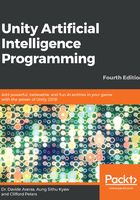
The behavior trees
Behavior trees are the other techniques used to represent and control the logic behind AI characters. They have become popular for the applications in AAA games such as Halo and Spore. Previously, we have briefly covered FSMs. FSMs provide a straightforward way to define the logic of an AI character, based on the different states and transitions between them. However, FSMs are considered challenging to scale and reuse. To support all the scenarios which we want our AI character to consider, we need to add many states and hardwire many transitions. So, we need a more scalable approach when dealing with more extensive problems. Behavior trees are a better way to implement AI game characters that could potentially become more and more complex.
The basic elements of behavior trees are tasks, where states are the main elements for FSMs. Tasks are linked together by control flow nodes in a tree-like structure. There are many commonly used nodes such as Sequence, Selector, and Parallel Decorator while tasks are the leaves of the tree. For example, let's try to translate our example from the FSM section using a behavior tree. We can break all the transitions and states into basic tasks:

Let's look at a Selector node for this behavior tree. Selector nodes usually are represented with a circle and a question mark inside. A Selector node tries to execute all the child tasks/sub-trees in order until one of them succeeds. First, it'll choose to attack the player. If the Attack task returns success, the Selector node is completed, and it goes back to the parent node—if there is one. If the Attack task fails, it'll try the Chase task. Finally, if the Chase task fails, it'll try the Patrol task:

What about the tests? They are also one of the tasks in the behavior trees. The following diagram shows the use of Sequence nodes, denoted by a rectangle with an arrow inside it. The root Selector starts with the first Sequence action. This Sequence action's first task is to check whether the player character is close enough to attack. If this task succeeds, it'll proceed with the next task, which is to attack the player. If the Attack task also returns success, the whole Sequence returns success, and the Selector is done with this behavior, and it does not continue with other Sequence nodes. If the Close enough to attack? task fails, then the Sequence action does not proceed to the Attack task and returns a failed status to the parent Selector node. Then the Selector chooses the next task in the Sequence, Lost or Killed Player:

The other two common nodes are Parallel and Decorator. A Parallel node executes all of its child tasks at the same time, while the Sequence and Selector nodes only execute their child tasks one by one. A Decorator is another type of node that has only one child. It can change the behavior of its own child's tasks, which includes whether to run its child's task or not, how many times it should run, and so on.
We'll look into more details and study how to implement a basic behavior tree system in Unity in Chapter 9, Behavior Trees.